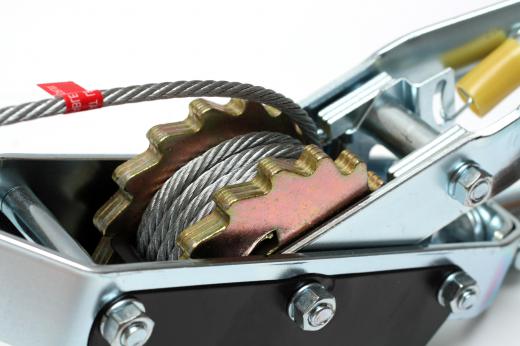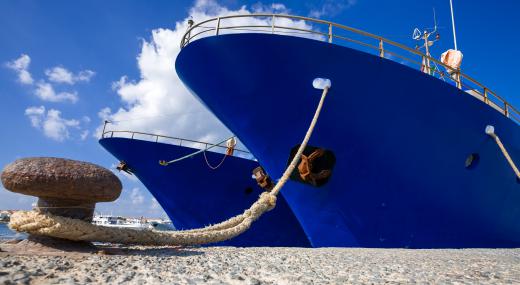A come-along is a hand operated ratchet lever winch. A winch is a mechanical device used to wind a rope or cable, while a ratchet is a mechanical brake that keeps the line from unwinding. Come-alongs are convenient and portable enough to use in almost any situation, because they are small enough to carry in one hand and weigh an average of only 10 pounds (about 4.54 kilograms).
These tools are used for pulling joints together, for straightening heavy panels while putting them in place, as safety ties, and for pulling the frame of a new construction together during its raising. They can also be used for stretching, lifting, and lowering objects. In addition to construction and industrial applications, a come-along is useful for towing boats, cars, and gliders. On boats and ships, it can be used to pull anchor or mooring lines, sheets, and halyards.

A come-along can be purchased in a variety of sizes and weight lifting capacities for varying construction needs. Lifting capacity generally ranges from 1 to 3 tons (907.19 to 2721.6 kilograms), with a 6 to 12 foot (about 1.83 to 3.66 meters) lift height. It is important to adhere to the recommended weight limits provided with the tool, as it is susceptible to fatigue fractures if repeatedly operated at even a small percentage of its tensile breaking strength.

Many come-alongs are designed with internal clutches in order to limit operating loads. Within these limits, however, the wire rope can rust from the inside out. In addition, the cross sections of chain links are reduced through wear. Frequent lubrication will extend the life of the device.
A come-along can also be equipped with a web strap to prevent twisting, as well as a safety feature called a breakable stress link. If it is overloaded, the stress link breaks. This lets the operator know to back off the load before the fiberglass handle snaps, preventing both personal injury and equipment damage. The stress link can be easily replaced if damaged. Replacing the stress link is far less costly and difficult than if further damage were to occur to the equipment due to excessive stress.
How To Use a Come Along Winch

Come alongs are used primarily the same way winches are used and for similar tasks. The difference is that winches are electrically or hydraulically operated, whereas come alongs are hand-powered. Always ensure proper precaution is taken to not overload the cable or chain. Wear safety protection such as safety glasses and gloves.
- Attach the come along's chain end or hook end to the object being pulled.
- Attach the other end of the come along to an anchor point.
- Check the chain or cable for binding, buckling, and kinking.
- Ensure the come along is pulling straight with no obstructions. Only pull at an angle when using a pulley or snatch block.
- Push down the come along's hand lever to operate the winch and begin pulling the object. Pull the handle back up and push down again to ratchet.
- Continue ratcheting the handle and pulling the object while periodically checking the cable or chain for issues. Continue to check the alignment of the object being pulled. Move the come along's chain or cable if possible to even out the pulling.
Types of Come Along Winches
Some come alongs are designed with an electric motor, but that's cheating. Those are really winches. A real come along is a hand-powered device that is simple, useful, and requires no electricity or gasoline. Most of them use a cable to pull and wrap around a drum, but some more crude devices can use a chain instead of a cable.
Countless different brands produce come alongs and they are manufactured all over the world. Some people will choose tools from certain brands because they are used to receiving a particular level of quality from that brand. A good quality come along will pull its designed weight effortlessly, will not bend easily, and can be used for many years before breaking or rusting away.
- Chain Pull
- Cable Pull
- With Hooks/Shanks/Loops
- Light Duty
- Heavy Duty
How Much Weight Can a Come Along Winch Pull?
The pulling capacity of any come along is going to be mentioned on its particular specifications sheet. When buying from a store, make sure the box or the price tag includes the capacity of the device. When buying online, the model should explain in the listing what it is made of, how big it is, and what weight capacity it is rated safely for. A higher price is not necessarily an indication of a higher pulling capacity.
Heavy-duty come alongs can reach pulling capacities above 4 or 5 tons. This is especially useful for pulling stalled vehicles or raising anchors on a boat. Smaller come alongs work well in workshops that require moving heavy objects only a small distance at a time while assembling.
A come along, just like a winch or chain, is only as strong as its weakest link. If any part of the device becomes compromised, the integrity of the device diminishes and it will not be able to lift or pull as designed. General safety rules for companies that use come alongs will require routine checks on come alongs for flaws. Additionally, each come along will include a safety checklist from the manufacturer.
Are Come Alongs a Safe Choice for Moving Heavy Objects?
Come alongs can be very safe tools when they are used properly and within their limits. A come along should never be used as an overhead crane. There are other tools more suited for this, such as chain hoists and actual shop cranes that roll on the ceiling's steel beams. The pulling capacity of a come along isn't necessarily the same as its lifting capacity if the tool were to be used in a lifting situation.
Similar to winches, come alongs shouldn't be used to pull around corners or at angles. This can cause problems with the cable rubbing on objects. The only way to turn corners or pull at angles is with a pulley or similar device. This ensures the cable can roll along a guided edge that can withstand the weight. Using snatch blocks and pulleys in conjunction with a come along can also increase the come along's pulling strength.
Versatility of Winches and Come Alongs for Towing
The come along will always be a useful tool because it can work without needing any sort of electricity or fuel. It can be carried in a tool bag or a truck toolbox. Winches, on the other hand, are bolted down to the front or back of trucks. The winch requires power, which means if the tow truck loses power, or if the motor on the winch burns up, the whole operation is over. A come along can be used as a solid backup tool for when the tow truck's winch breaks down. All the come along needs is a quick visual inspection, and then attach one end to the anchor point and the other end to the vehicle being towed. Crank by hand. Repeat.
